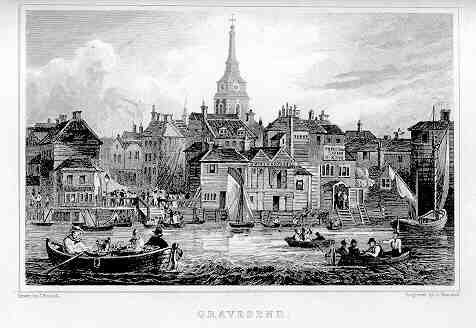

 |
The Parish Church was St Mary's in Pelham Road, where the White Post Tavern now stands, but the original Parish Church having fallen into disrepair, King Henry VIII granted permission to call St George's the Parish Church. In 1727 the old building was totally destroyed by fire, but was re-erected in 1731, King George II and Queen Caroline contributing to the funds. The Register of Burials dates from 1547, Baptisms 1651, Marriages 1653. Among the entries in the first-named is one that has interest for Americans in particular, and for lovers of romance generally. This runs: 1616 "March 2j. rebecca wrothe, wyff of Thomas Wrothe, gent., a Virginian lady borne, here was buried in ye Chancell." One would scarcely recognize Pocahontas, the daughter of the Indian chief Powhatan, in that entry, but when we remember the details of her history - how, after Captain John Smith, whose life she had saved, left Virginia in 1609, she was held by the colonists of Jamestown and at last converted to Christianity in 1613, with the name of Rebecca given to her - the identification becomes clearer. In 1613 she married Thomas Rolfe and the same year she came to England. Presented at Court, she was something of a "social success", but the vagaries of the English climate, or, according to the romantic story, a broken heart, adversely affected her health. She was actually on board a ship, intending to return to Virginia, at the time of her death. The body was brought ashore at Gravesend, and buried, as the entry states, in the chancel of the Parish Church. A good deal of controversy has taken place as to whether the chancel was that of St Mary's or St George's.
On July 16th, 1914, a memorial to the Indian Princess was unveiled in the church. It takes the form of two stained-glass windows subscribed for by "Dames of Virginia" - in another sense Virginia ladies born - descendants of British families dwelling in America at the time of the War of Independence. These windows were unveiled by the then United States Ambassador in the presence of numerous English and American visitors, and of sailors from ships of the American navy then lying in the Thames off Gravesend. The chief feature of these windows is that of the Biblical character, Rebecca, after whom Pocahontas was christened. Rebecca, with the pitcher of water upon her shoulder, typifies the services rendered by the Indian girl to the early settlers. A further group of Ruth and Naomi, with the words "Thy people shall be my people, and thy God my God," is equally apposite. The tablet to Pocahontas has a long and interesting inscription.
Captain John Smith, one of the early adventurers in Virginia, died in 1631, and was buried in the church of St Sepulchre, hard by the Old Bailey, London.
Another memorial tablet in St George's, is that to General Charles Gordon, whose associations with the town were of an intimate character. He was appointed Commanding Officer, Royal Engineers, "to superintend the erection of the forts to be constructed in that locality for the defence of the Thames."
For more information regarding St George's and Pocahontas click here and/or here
Return to: